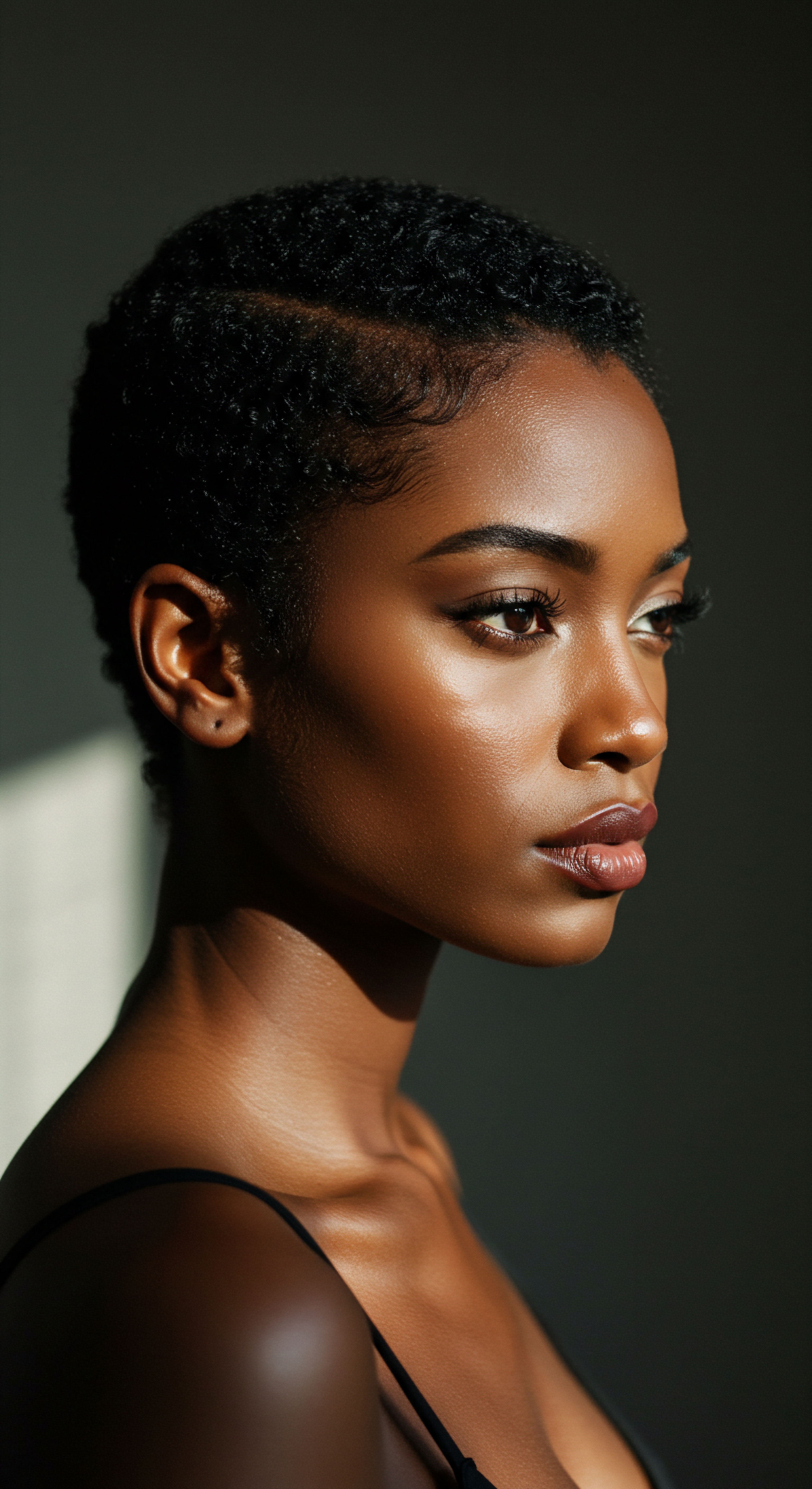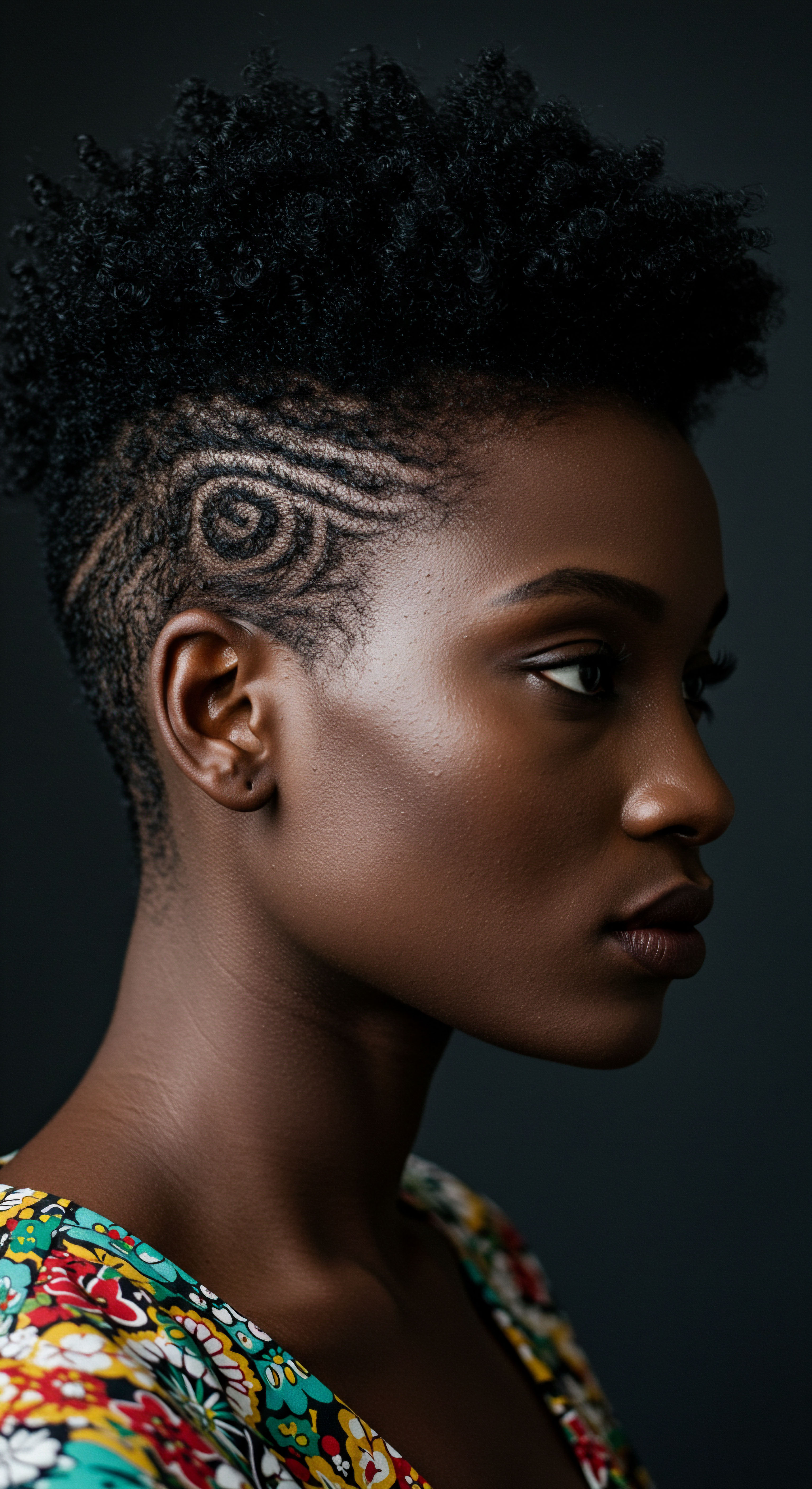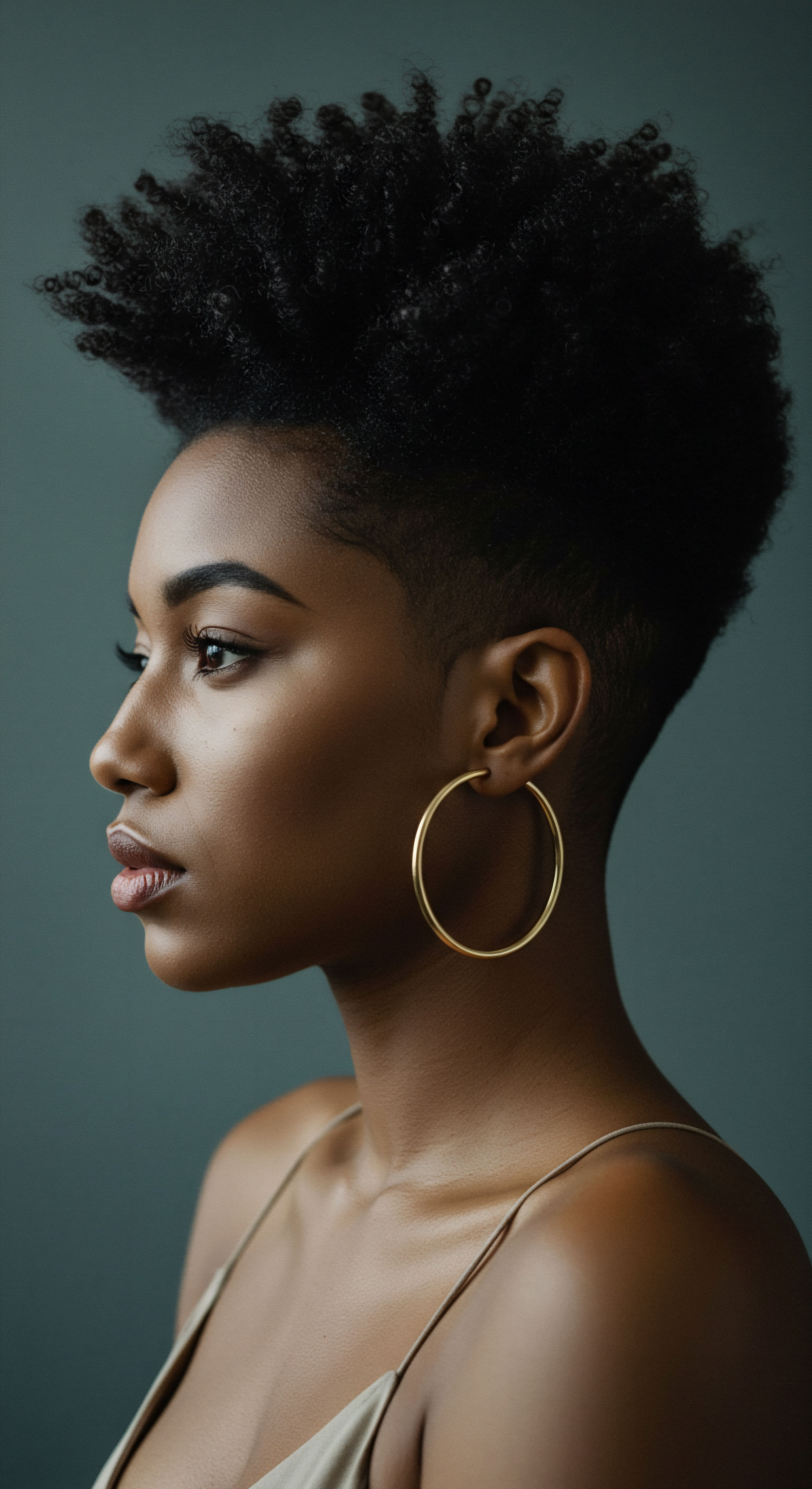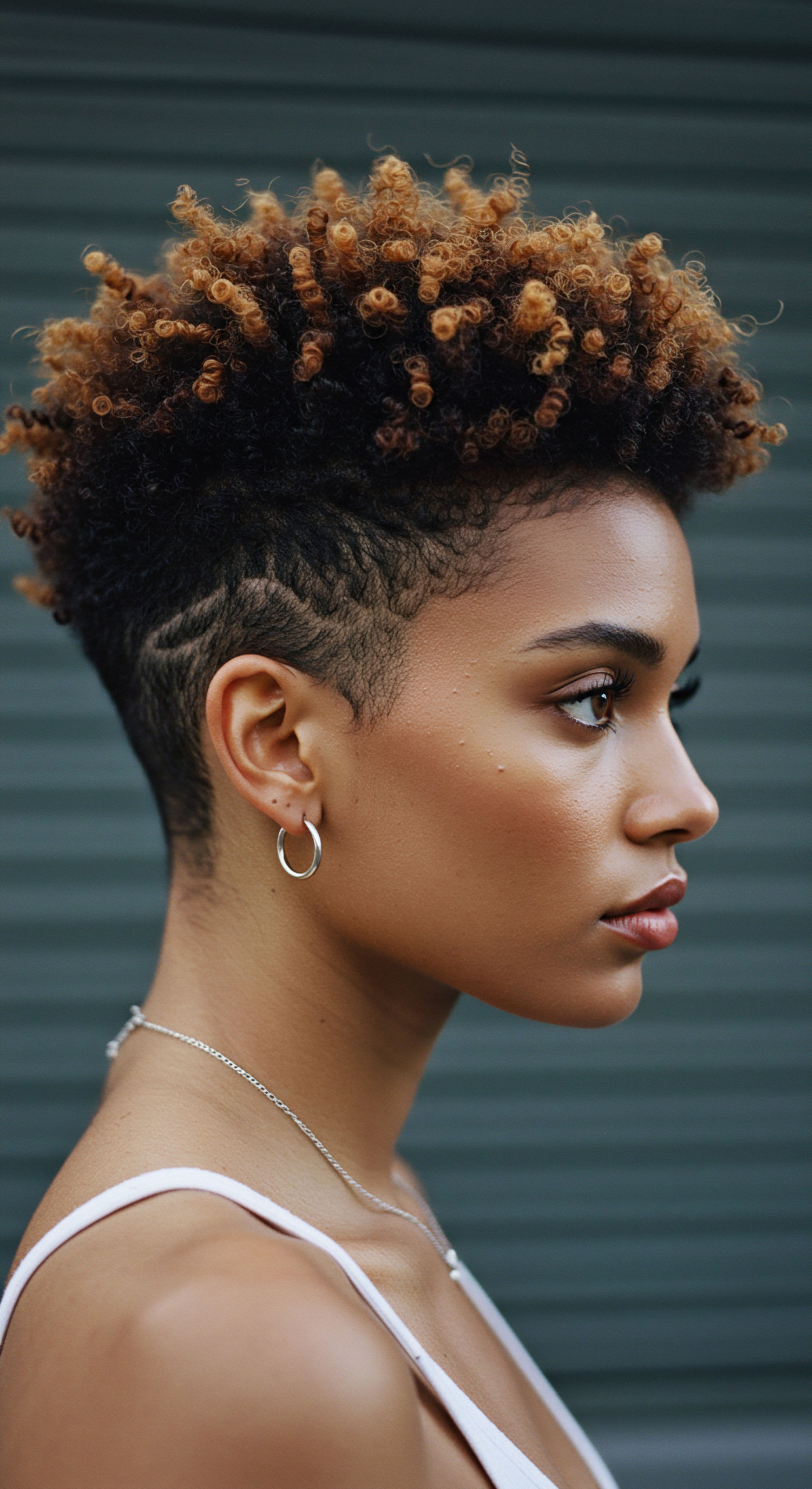
Roots
Consider, for a moment, the whisper of ancient winds across sun-drenched sands, carrying not just grains of desert but echoes of daily existence. How did the relentless Egyptian sun, the pervasive dust, and the scarcity of cool shade shape the very way people presented themselves, particularly their hair? This query reaches beyond mere aesthetics, inviting us to contemplate a profound interplay between environment and human ingenuity, a dance between survival and expression. It beckons us to consider how the fundamental conditions of a specific place could guide the choices made about something as personal as a hair covering, revealing layers of practical wisdom beneath layers of linen.
Ancient Egypt, a civilization born of the Nile’s embrace, lived under a sky often devoid of clouds, where temperatures could soar, and the air frequently carried fine particulate matter. Such an environment presented unique challenges for hair care and preservation. Without modern shampoos or conditioners, maintaining scalp health and hair cleanliness in a dusty, hot climate was a constant endeavor. This environmental pressure was not merely a backdrop; it was an active participant in the design and adoption of hair coverings, influencing their materials, forms, and the very reasons for their widespread use.

Climate as a Sculptor of Style
The climate of ancient Egypt, characterized by its arid conditions and intense solar radiation, was a primary force in shaping human adaptation, including choices regarding personal adornment and protection. Daytime temperatures often exceeded 30 degrees Celsius (86 degrees Fahrenheit), and even at night, the air could retain considerable warmth. This heat, coupled with the ever-present fine sand and dust, created a demanding environment for exposed skin and hair.
Hair, particularly textured hair, with its diverse curl patterns and varying porosities, requires thoughtful management in such conditions. Without protection, it can become dry, brittle, and prone to breakage from sun exposure. Dust and sand could accumulate, leading to irritation and hygienic concerns. The ancient Egyptians, keenly attuned to their surroundings, devised solutions that addressed these practical challenges while also conveying social meaning.

What Did the Earliest Coverings Provide?
The initial purpose of many early hair coverings was undeniably practical ❉ protection. From the scorching sun, which could cause sunburn and scalp damage, to the abrasive sand, which could irritate and dirty the hair, coverings served as a shield. The simple headcloth, perhaps a piece of linen draped over the head, offered an immediate barrier.
Linen, the primary textile of ancient Egypt, possessed qualities ideally suited to this climate. Its fibers are hollow, allowing for excellent airflow, which aids in cooling through evaporation. It is also highly absorbent, capable of wicking away moisture from the skin. These properties made linen an intelligent choice for garments and head coverings alike, providing a degree of comfort and cleanliness in the heat.
- Linen ❉ Its breathable and moisture-wicking qualities made it ideal for head coverings in the hot, arid climate, aiding in thermal regulation and hygiene.
- Wigs ❉ Served not only as symbols of status but also as practical solutions for hygiene, protection from the elements, and a canvas for elaborate styling without exposing natural hair to daily wear.
- Oils ❉ Applied to both natural hair and wigs, these helped to condition, protect from dryness, and act as a barrier against dust, maintaining hair integrity in a harsh environment.

Wigs and Their Practicality in Arid Lands
Beyond simple cloths, wigs became a prominent feature of Egyptian hair culture. While often associated with status and ritual, their widespread adoption also held significant practical implications directly linked to the climate. Shaving the head and wearing a wig offered a means of hygiene that was difficult to maintain with long, exposed natural hair in a dusty environment.
Lice, a persistent problem in ancient societies, were more easily managed on a shaved scalp. A wig could be removed, cleaned, and re-styled, offering a level of control over personal hygiene that was revolutionary for its time.
Furthermore, wigs, often crafted from human hair, plant fibers, or even wool, could be dressed with scented animal fats and plant resins. These unguents, while contributing to fragrance, also served a practical purpose ❉ they conditioned the hair, protected it from the sun’s drying effects, and helped to repel dust. The dense structure of a wig, paradoxically, could also offer a layer of insulation against the direct heat of the sun, much like a well-ventilated hat.
The design of Egyptian hair coverings fundamentally responded to the arid climate, offering essential protection from sun and sand while addressing hygiene.

Ritual
Moving beyond the elemental demands of climate, we consider how practical adaptations to environmental conditions could gradually take on deeper significance, becoming embedded in daily practices and societal customs. The transition from simple protection to ritualistic practice often begins with a practical solution that proves effective and then, through repeated use and cultural affirmation, accrues layers of meaning. For the ancient Egyptians, hair coverings, initially born of climatic necessity, certainly followed such a trajectory, evolving into powerful symbols and integral components of both private care and public presentation.
The meticulous care observed for wigs and natural hair, even when concealed, points to a deeper understanding of personal presentation and well-being. This was not merely about avoiding discomfort; it was about a regimen, a series of deliberate actions that transformed the mundane act of covering one’s head into a ritual of self-respect, social conformity, and spiritual alignment.

How Did Daily Hair Management Shape Practices?
The daily reality of living in ancient Egypt meant a constant battle against dust, sweat, and the drying effects of the sun. This led to a highly developed system of hair and scalp care. Hair was often oiled with castor, moringa, or almond oils, not just for luster but for protection and conditioning. These oils, along with various herbal remedies, were applied to the scalp to soothe irritation and maintain moisture.
Hair coverings, particularly wigs, became central to this regimen. They allowed natural hair to be kept short or shaved, simplifying hygiene. The wigs themselves were often intricate constructions, requiring regular cleaning and re-styling by skilled artisans. This process, far from being a simple task, became a routine, a ‘ritual’ of maintenance that preserved both the object and the wearer’s appearance.
The act of donning a wig or carefully arranging a headcloth was a deliberate one, a step in preparing for the day that blended practical protection with an aesthetic ideal. It allowed individuals to present a polished, controlled appearance, despite the challenging environmental conditions. This control over one’s external presentation was deeply valued in a society that placed high importance on order and decorum.

Symbolism Beyond Sun Protection
While the initial impetus for hair coverings may have been climatic, their meanings quickly expanded. The various styles of wigs and headcloths, from the simple cap-like styles worn by commoners to the elaborate, multi-layered wigs of the elite, communicated social standing, profession, and even religious affiliation. The ‘nemes’ headcloth, famously associated with pharaohs, transcended its function as a mere covering, becoming an undisputed emblem of royal authority.
This evolution from utility to symbolism is a testament to the adaptive nature of human culture. What began as a response to a harsh environment became a language of identity. The materials themselves, especially fine linen, also held symbolic weight.
The purity and cleanliness associated with linen, a plant fiber, aligned with Egyptian religious beliefs emphasizing purity. Wearing clean, well-maintained linen coverings was a sign of respect, both for oneself and for the deities.
| Covering Type Wigs |
| Key Material Human Hair, Plant Fibers |
| Climatic Influence Hygiene, Sun Protection, Thermal Regulation |
| Social/Ritualistic Function Status, Wealth, Formal Appearance, Religious Purity |
| Covering Type Nemes Headcloth |
| Key Material Linen |
| Climatic Influence Sun Protection, Dust Barrier |
| Social/Ritualistic Function Pharaonic Authority, Divine Connection |
| Covering Type Khat Headcloth |
| Key Material Linen |
| Climatic Influence Daily Protection from Sun and Dust |
| Social/Ritualistic Function Common Wear, Simplicity, Utility |
| Covering Type Veils/Scarves |
| Key Material Linen |
| Climatic Influence Face and Neck Protection from Sun/Sand |
| Social/Ritualistic Function Modesty, Adornment, Status (depending on fabric quality) |
| Covering Type Egyptian hair coverings adapted to climate while evolving into symbols of identity and ritual. |
Hair coverings, originally practical responses to the climate, evolved into complex symbols of social status and ritualistic practice.

Relay
Having explored the foundational responses to climate and the subsequent layering of ritualistic meaning, we now consider the deeper, more interconnected currents that shaped Egyptian hair coverings. This level of inquiry demands a look at the intricate relationships between environmental factors, technological advancements, social stratification, and the very perception of beauty and health in a society. It is here that we truly begin to discern how the seemingly simple act of covering one’s head became a sophisticated expression of a civilization’s collective adaptation and aspirations.
The influence of climate extended beyond mere comfort, penetrating the economic structures that supported the production of hair coverings and the scientific understanding of materials. The very choice of flax cultivation, for instance, was intrinsically tied to the Nile’s annual inundation and the subsequent fertile lands, providing the raw material for linen, the ubiquitous fabric. This interdependence speaks to a holistic approach to living, where environmental constraints were met with resourceful innovation.

How Did Material Science Meet Environmental Demands?
The selection of materials for hair coverings was not arbitrary; it was a testament to a pragmatic understanding of thermal properties and textile science, albeit an ancient one. Linen, derived from the flax plant, was paramount. Its microscopic structure allows it to absorb and release moisture rapidly, creating a cooling effect as sweat evaporates. This property, known as Hydrophilicity, is a key reason linen remains a preferred fabric in hot climates even today.
A study published in the journal Textile Research Journal analyzing the thermal comfort properties of various fabrics, while modern, offers insight into the enduring qualities of linen. It highlights linen’s high air permeability and thermal conductivity compared to many other natural fibers, meaning it allows heat to dissipate from the body effectively and permits air to flow through it with ease. This empirical data, though from a contemporary context, underscores the intuitive wisdom of the ancient Egyptians in selecting linen for its cooling capabilities, a direct response to their hot environment.
For wigs, materials ranged from human hair, meticulously sourced and processed, to plant fibers like palm leaves, and even wool. The choice often depended on social status and the desired effect. The inner construction of wigs sometimes involved a netting or cap structure, allowing for some air circulation against the scalp, a subtle yet crucial design element for comfort in the heat. The application of oils and resins to wigs also served a dual purpose ❉ not only for scent and cosmetic appeal but also to create a protective barrier against the pervasive dust and the sun’s drying rays, akin to an ancient, natural leave-in conditioner.

Did Coverings Mitigate Health Challenges?
Beyond direct protection from sun and sand, hair coverings played a significant role in mitigating health challenges prevalent in ancient Egypt. One notable concern was the prevalence of head lice and other parasites. Archaeological findings, such as those from the mummified remains, frequently reveal evidence of lice infestations. For instance, a 2012 study published in the Journal of Archaeological Science examined hair samples from ancient Egyptian mummies, confirming the widespread presence of head lice eggs (nits) on hair strands.
In such a context, shaving the head, a common practice for many Egyptians, and then covering it with a wig or headcloth, offered a remarkably effective public health measure. A shaved scalp is far easier to clean and inspect for parasites than long, dense hair. Wigs, being removable, could be treated separately, perhaps by heating or chemical application, to eliminate infestations without direct contact with the scalp. This systematic approach to hair management, driven by a need for hygiene in a densely populated, warm environment, illustrates a sophisticated, if unwritten, understanding of public health principles.
The practice of wearing head coverings also likely reduced the incidence of scalp infections and skin lesions caused by prolonged sun exposure and abrasive dust. The covering acted as a physical barrier, preventing direct contact with irritants and reducing the likelihood of sunburn, which could lead to secondary infections in a pre-antibiotic era.
Ancient Egyptian hair coverings represent a sophisticated intersection of material science, public health, and social expression, all shaped by the demands of their arid climate.
This intricate relationship between environment and adornment extends to the very structure of society. The production of linen and wigs required a skilled workforce, from flax cultivators and weavers to wig makers and barbers. This industry, sustained by the constant demand for climatic adaptation and social expression, formed a vital part of the Egyptian economy. The availability and quality of these coverings, therefore, reflected not only personal choice but also the economic capacity and social standing of the wearer.
The design choices, from the simple practicality of the khat to the ceremonial grandeur of the nemes, were not merely artistic whims. They were the distilled wisdom of generations, responding to the persistent environmental pressures of the Nile Valley. They demonstrate how human creativity, when faced with environmental constraints, can produce solutions that are both eminently practical and deeply symbolic.
| Climatic Factor Intense Sun |
| Design Element/Feature Dense Wig Construction, Multi-layered Headcloths |
| Underlying Principle UV Protection, Insulation from Direct Heat |
| Climatic Factor Dust/Sand |
| Design Element/Feature Full Coverage, Oiled Surfaces of Wigs |
| Underlying Principle Physical Barrier, Particle Repulsion |
| Climatic Factor High Heat |
| Design Element/Feature Linen Fabric, Shaved Scalps beneath Wigs |
| Underlying Principle Breathability, Moisture Wicking, Enhanced Hygiene |
| Climatic Factor Parasite Risk |
| Design Element/Feature Removable Wigs, Shaved Scalps |
| Underlying Principle Ease of Cleaning, Pest Control |
| Climatic Factor Egyptian hair coverings adapted strategically to environmental challenges, balancing protection with comfort. |

Reflection
As we conclude our consideration of ancient Egyptian hair coverings, a quiet understanding settles upon us ❉ that the threads of human history are woven not just with grand narratives of pharaohs and pyramids, but with the subtle, everyday choices made in response to the world around us. The story of these coverings is a testament to resilience, to the enduring human capacity to find grace and order amidst the relentless forces of nature. It reminds us that our relationship with our hair, and indeed with our appearance, has always been a conversation with our environment, a dialogue that shapes us as much as we shape it.
From the dry winds of the desert to the careful selection of linen, from the practical hygiene of a shaved scalp to the ceremonial weight of a nemes, each choice reflects a deep, intuitive wisdom. This historical exploration gently encourages us to look at our own hair journeys with renewed eyes, perhaps seeing the enduring echoes of ancient ingenuity in our modern routines. The wisdom of the past, in its quiet dignity, continues to whisper lessons of adaptation and mindful care.

References
- Fang, Z. & Chen, H. (2012). Thermal comfort properties of selected fabrics. Textile Research Journal, 82(12), 1251-1259.
- Araujo, A. et al. (2012). The presence of head lice (Pediculus humanus capitis) in ancient Egyptian mummies. Journal of Archaeological Science, 39(12), 3624-3628.
- Fletcher, J. (2016). The Hair ❉ The History of Hair in Ancient Egypt. Manchester University Press.
- Robins, G. (2001). The Art of Ancient Egypt. Harvard University Press.
- Shaw, I. (Ed.). (2000). The Oxford History of Ancient Egypt. Oxford University Press.
- Germer, R. (1997). Mummies ❉ Life After Death in Ancient Egypt. Prestel.
- Baines, J. & Malek, J. (2000). Cultural Atlas of Ancient Egypt. Checkmark Books.